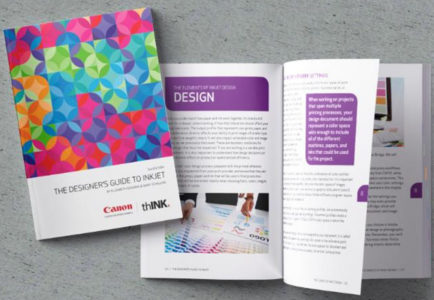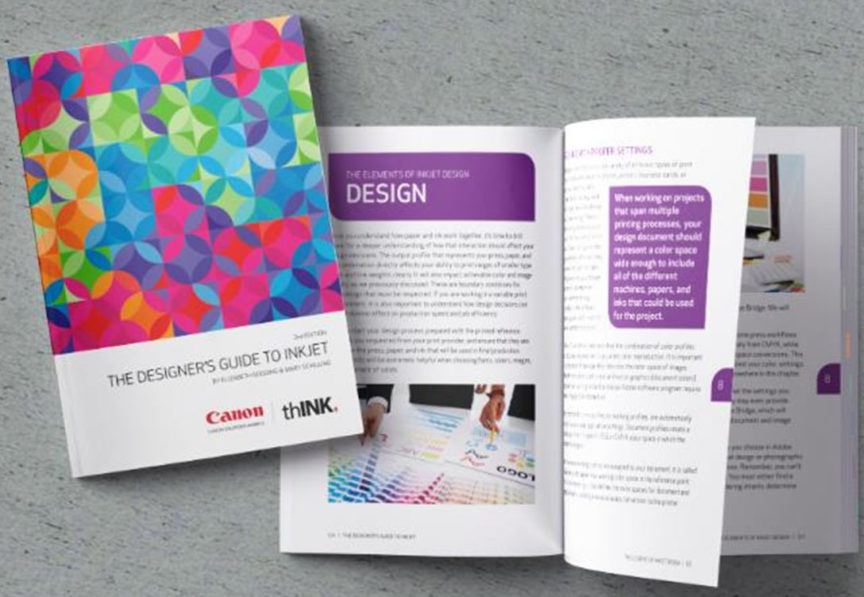The Designer’s Guide to Inkjet has been a go-to resource for the IWCO Direct team since it was first published in 2014. My personal copy is dog-eared and filled with Post-It notes, marking pages I go back to on a regular basis. One of the best things about the Guide is the Glossary. When production inkjet was introduced to the market, we had to learn a new language—or at least a new dialect to communicate with our vendor partners, internal teams, and most importantly, our customers about this great new platform that changed minds about the power of inkjet.

The original glossary begins with the definition of “additive color” and ends with “wrap envelope.” There were 139 terms in between them, many of which were new then, but roll off our tongues now. As authors Elizabeth Gooding and Mary Schilling state in the introduction, “The inkjet of today has advanced by leaps and bounds since 2014 and more options mean there’s more to learn.”
The glossary for the 2018 edition of the Guide proves that production inkjet requires continuing education. Thirty-six terms were added to the glossary, but my favorite entry remains:
Headache: The pain experienced when the printer rejects a job prior to production or when the job prints with lower than expected print and color quality.
Paper Stocks and Ink Sets Have Changed Dramatically in a Few Short Years
One of the biggest changes to occur between the first and second editions of the Guide is the subject of paper. The first edition used the lofty chapter title “Media is Your Canvas – Choose Wisely.” That became a subhead in the 2018 edition for the chapter called, “Paper – The Foundation for Design.” Many of the new glossary entries are paper-related because the range of papers available for production inkjet has expanded so dramatically. For example, in 2014 there was no need to include a definition for “highly surface calendered” because it could not be used on a production inkjet device.
Some would argue that ink sets have expanded more than paper for production inkjet. The glossary proves this again, adding terms like “high-density polymer pigment.” As the glossary explains, this term means “A high-density ink that has various levels of polymer chemistry incorporated into its ink composition. Also called “resins,” polymer chemistry added to ink to create a string structure to assist with drop formation, reducing satellite drops from a print head.”
“Satellite drops” is not a new term, but remains something to be avoided. As the glossary tells us, satellite drops are “unintended drops which are jetted between or around intended drops. Satellite drops can cause areas of detail to be blurred.”
A Trusted Resource for Many Situations
One of the greatest values of the glossary in the Designer’s Guide to Inkjet is recognizing terms that may be used in different ways on different platforms. The best example of this is “profile.” The entry directs the reader to check “Input Profile, Output Profile, Machine Profile, Machine Monitor Profile, Document Profile and Paper Profile.” The authors then remind us that “in the context of inkjet, “profile” refers to the input or output machines reproducible color space.”
Need to explain the difference between “inkjet coated paper” and “inkjet treated paper” to a customer who is new to production inkjet and wary of making a specification mistake when transitioning a program from conventional offset to this “new” platform? The glossary proves its value again by clearly explaining the difference:
Inkjet Coated Paper: Paper with a smooth surface that contains a coating chemistry designed for fast drying of aqueous inks. These fast drying surfaces restrict the amount of ink that can be absorbed by the paper which allows the ink colorant to stay on the surface.
Inkjet Treated Paper: Paper with a surface or internal fiber chemistry that contains a fixative treatment to separate the colorants from the liquid carrier of the ink in order to hold more colorant near the paper surface.
While much has been updated, some things have not changed between the first and second edition. Like the 2014 edition, the 2018 update still starts with “additive color” and ends with “wrap envelope.” It also remains and invaluable resources for print and marketing professionals of all types, which is why my 2018 version is starting to look as well-worn as its older brother.
 As manager of digital print operations at IWCO Direct, Robert is responsible for providing leadership for all digital print operations at the company’s Chanhassen facilities, encompassing cut-sheet and continuous devices with both monochrome and full color capabilities. He played an instrumental role in developing IWCO Direct’s digital print capabilities, and continues to help refine and expand the company’s service offerings. He can be reached at robert.clark@iwco.com.
As manager of digital print operations at IWCO Direct, Robert is responsible for providing leadership for all digital print operations at the company’s Chanhassen facilities, encompassing cut-sheet and continuous devices with both monochrome and full color capabilities. He played an instrumental role in developing IWCO Direct’s digital print capabilities, and continues to help refine and expand the company’s service offerings. He can be reached at robert.clark@iwco.com.


Comments
Robert you hit the nail on the head. I’ve recommended this book to several print shops. It’s good to see IWCO considers all the angles. We’ve enjoyed doing business with you’re company. It’s no mistake that IWCO has there act together. I also enjoyed Mary and Elizabeth’s sense of humor throughout the book. It’s a little dry perhaps but funny. Great read loved the book, mines dogeared also.